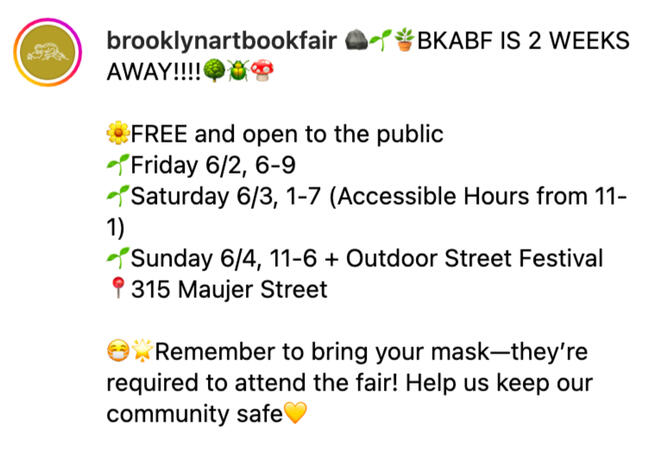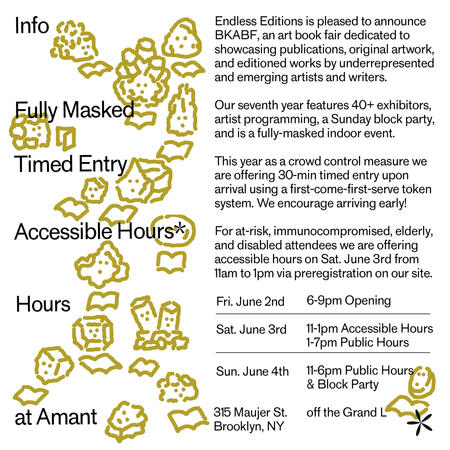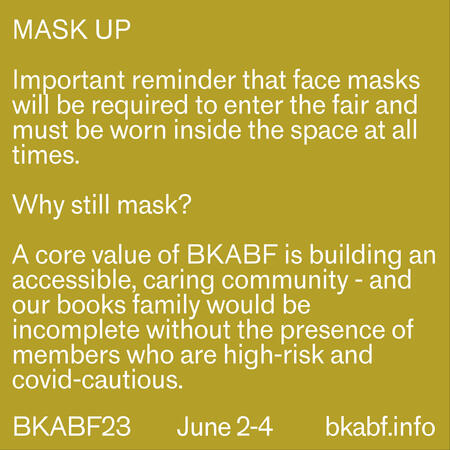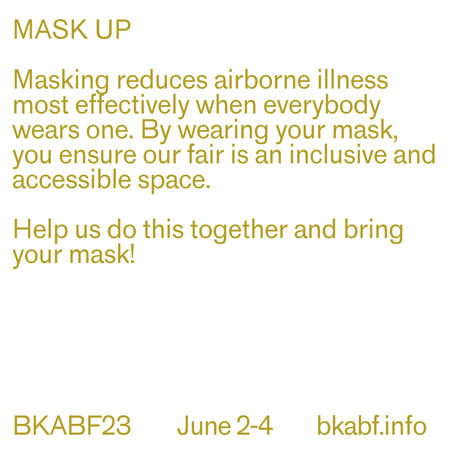MASKING AT EVENTS IN 2023: notes on policies & strategies from the brooklyn art book fair
Hi! We're the organizing team of the 2023 Brooklyn Art Book Fair, which was a fully-masked event spanning three days with over 3,000 visitors.Since we experienced a high compliance rate with our mask policy, some individuals and organizations reached out with questions on how we made it happen. We thought we'd compile a bit about our goals, policies, and strategies to make a Covid-safer event! We hope this doc might help other organizations who’d like to implement similar requirements.NOTE: None of us have formal event accessibility training, and this resource is not intended to be taken as an official guide on accessibility policy. There is ample room for improvement and critique. Our main hope is to provide a jumping-off point for others!- Marisha Lozada, Sarula Bao, & Sana Masud
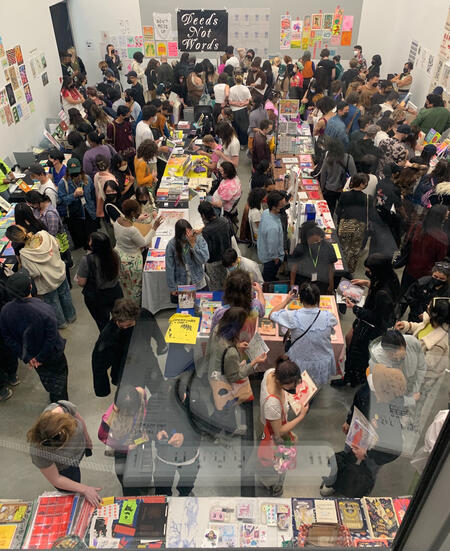
OUR GOALS
1. A COVID-SAFER EVENT
We recognize that large gatherings are still unsafe for many. However, a fully masked event is far safer and more inclusive than a mask-optional one. As fully-masked events become rarer, we hoped even this baseline Covid mitigation would have a positive impact.We also designated accessible hours via pre-registration to provide a less-crowded experience for immunocompromised, disabled, elderly, and high-risk folks (more on that later).2. HIGH MASK COMPLIANCE (REGARDLESS OF MASK TYPE)
Respirators protect best against Covid and other airborne illness—but as masking becomes uncommon for many, we chose to also support surgical and cloth masks, as we believe the best mask is the mask you'll actually wear.We provided a variety of mask options including surgical, KN95, and two types of N95 so visitors had a choice even within the requirement. Maintaining a fully-masked space was most important to us, as the consistent visual unity meant everyone was more likely to comply.3. A FRIENDLY, CELEBRATORY, ENCOURAGING VIBE
We strove to meet people where they were at, and encouraged them to respect our event’s values and protect our community’s vulnerable members. Our primary goal in this instance was to get everyone to wear a mask—not to educate about Covid.As Covid is increasingly downplayed on a systemic level, we hoped that producing a fully-masked event would create impactful images of a space where masking exists alongside celebrations of community. We hoped to show that this baseline Covid mitigation could still be achieved with strong attendence, even post-PHE.
MESSAGING
(please take our copy and use it word-for-word if u want this is open source baby!!!!)A large part of our approach hinged on widespread messaging. We wanted the phrase "fully-masked" to become associated with the event itself from early on so that visitors were prepared.Since the nature of our fair included juried exhibitors, we made our masking requirements clear in the application process. Our confirmation form for exhibitors included a reminder that the fair would be fully-masked, and asked them to check and sign that they understood this and agreed to wear a mask.Additionally:1. We included that BKABF would be a fully-masked event on all promotional materials leading up to the fair, including online posts, captions, and flyers (selected examples below)
2. In the week before the fair, we made a post briefly explaining our reasons for the mask requirement. We emphasized the importance of including and protecting our high-risk community members. (This sentiment fortunately already aligned with our event's long-standing values of being open and accessible to all.)While anyone can be impacted negatively by Covid, we found that people more readily accepted our mask request when we framed it around the protection of vulnerable communities.
3. In the week before the fair, we also provided a longer explanation of our mask policy to exhibitors in an informational email. It read:
MASKING + COVID-19 POLICY:
This fair is fully-masked indoors, including during setup! We will provide free N95 respirators to any vendor who requests them. We will also have free KN95 masks available through a generous donation from Covid Solidarity NYC.BKABF was organized with the intention of creating a space that is open and accessible to all. While we understand mask mandates are no longer common during events, we ask that you mask during BKABF as a sign that our space is safe and welcoming to anyone at risk of severe illness or disability from Covid. They deserve the same access to community events that celebrate books and art!If you are feeling ill or have been exposed to Covid, please let us know immediately and stay at home or at your accommodation. We will work with you to ensure your table and materials are taken care of. Your health and the health of our community are most important. There will always be more opportunities to table in the future! Thank you.
BKABF POLICIES
+ FACE MASKS REQUIRED INDOORS AT ALL TIMES
A fully-masked indoor fair space was our primary baseline goal. While Covid can still spread outdoors, the areas surrounding the fair were beyond our resources to control. We were fortunate to have a venue with multiple sections where people could step away from a crowd.+ ACCESSIBLE HOURS
We designated accessible hours from 11:00 AM - 1:00 PM with limited capacity and no lines for visitors who were immunocompromised, disabled, high risk, elderly, and/or used mobility aids. We provided free N95 masks during this time along with our regular selection of KN95s and surgicals. (As few people took the N95s, we had enough to provide during the fair's duration).Visitors pre-registered for accessibility hours via Eventbrite. Slots were determined based on lowering our venue's capacity. (Our venue generally accommodated around 150, and we reduced to 90 slots, which were all filled. In actuality, about 30-40 people showed up per each hour of accessible hours.)+ TIMED ENTRY
To improve crowd flow and reduce lines during regular hours, BKABF operated on a timed-token entry system. If long waits did occur, volunteers offered stools and water to visitors in line. Recurring indoor announcements also encouraged visitors to limit their time inside the fair to 45 minutes so that others had a chance to enter.+ EXHIBITOR GREEN ROOM
We provided a separate indoor space from the fair exclusively for exhibitors. This space provided a quiet refuge away from any event overwhelm.+ NO EATING INSIDE THE FAIR SPACE
We communicated with all staff, vendors, and volunteers that no unmasking and eating would be permitted inside the fair space. We were super lucky that our venue had ample outdoor seating where people could take breaks outside and eat. On the day of our block party, we also set up some picnic tables and risers for extra seating.
STRATEGIES
As mentioned earlier, our goal was to reach the baseline mitigation of a fully masked space. We recognized that members across the entire team of staff and volunteers took varying levels of Covid precaution in their personal lives, so our aim was to unite everyone at least for this single event.+ We emphasized that masks were required, NOT just strongly recommended. In previous experiences, we found that recommending masks puts the burden on people who were most likely to wear one anyway (and nobody else does). Since face masks work best when everybody wears one—especially if masks of varying quality are used—merely recommending masks can still exclude high-risk and covid-conscious people.+ We worked to unify all staff and volunteers in messaging and policy. We met with our venue contacts to discuss our reasons for being fully-masked, emphasizing that it was a promise we made to the public and our exhibitors. They then spread this explanation to their own staff, so that everybody working the event was on the same page.Here are some main points we used when discussing the topic:- We felt it extremely important to be unified in our messaging, especially since nearly all other NYC events of this scale do not require masks. We did not want visitors to hear conflicting information among staff and volunteers.- We emphasized that we had immunocompromised and disabled exhibitors who were depending on us to follow through on what we say and create a space that is safer for them.- We acknowledged that while many don't see Covid as a concern anymore, there are a large amount of people for whom unmasked spaces could lead to disability or death. This community has been systemically excluded from much of public life, and we did not want to further isolate or leave them behind.- We reiterated that our organization and book fair were founded on principles of giving marginalized folks opportunities to create and engage with art in an accessible way. We wanted to make sure that the experience we provided and our actions matched the values we advertise.+ We instructed all organizers, staff, and volunteers to model our policies by wearing their face masks when indoors and when interfacing with the public.+ We encouraged visitors bring their own masks in promotional materials. However, as masking becomes less common, we also provided a variety of options. Our venue purchased a large quantity of surgical masks. We also coordinated an incredible dontation from Covid Solidarity NYC, who worked with The People's PPE to provide us black KN95 and white N95 respirators.+ We drafted concise statements for volunteers and staff to say to visitors who were hesitant to mask. We also scripted announcements for the crowd if we noticed a lack of compliance. (We ended up not needing them, but here's what we wrote!)MASKING (repeat every hour or as needed)
“Hi everyone! This is a reminder to keep your mask on inside the fair space. Thanks for doing your part to keep our community safe!”(repeat as needed if many visitors remove masks)
“Hi everyone! This is an important reminder to keep your mask on at all times inside the fair space. A core value of this fair is building an accessible, caring community inclusive of people who are at high risk of severe illness or disability from Covid. Please keep our community safe and protect high-risk visitors, exhibitors, and staff by wearing your mask!+ We instructed volunteers to observe the fair space with mask boxes in hand. If they noticed any visitors remove their masks, they provided one.NOTE: While N95 and elastomeric respirators are most protective against Covid, to ensure as much compliance as possible, we took aesthetics and comfort into consideration for our mask offers. We found people overwhelmingly grabbed the black KN95 masks—even over black surgicals!If your goal matches ours—that any mask is better than no mask—considering the mask aesthetics and ease of use may yield a more successful compliance result. (That said, we still felt it important to offer N95s. We even purchased a quantity of 3M Auras for staff, exhibitors, and volunteers before our respirator donation was secured.)
IN PRACTICE
+ All staff, organizers, and volunteers wore their face masks when inside the fair and when interacting with visitors. This provided an instant visual reminder of our expectations and conveyed that we took our own requirements seriously.+ To enter the fair, visitors first had to stop by a welcome table with fair guides and masks. Volunteers at the table provided some fair info, including a friendly request: "we ask that you wear a mask at all times indoors" and invited guests to take their pick from our supply.+ We strove to keep all masking request language kind, friendly, and appreciative so that visitors felt encouraged and welcomed.
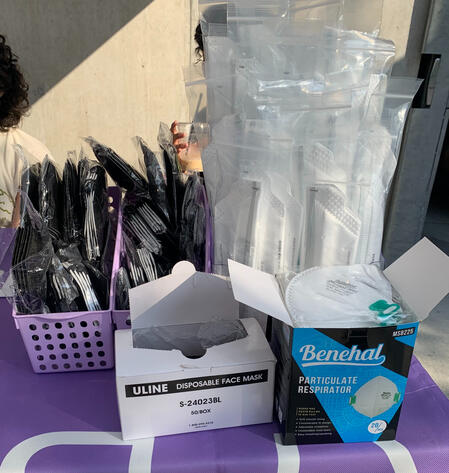
+ After receiving their masks and guides, visitors walked toward the main door, where another staff member tracked the crowd to ensure we stayed under our venue's capacity. This staff member also ensured that everyone wore their masks as they entered.+ Signage on the entrance door also clearly conveyed mask requests+ All staff, organizers, and volunteers wore visible STAFF badges, which helped make masking requests feel very official lol
NOTES & CONCLUSION
+ Since even fully-masked indoor events are not entirely safe during Covid, eventually hybridizing all (or even some) parts of the fair to have online elements would be amazing. Since we're a small team of volunteer labor, creating a simultaneous online fair is currently far beyond our resources and capacity, but introducing more online elements could be possible in the future. If you're planning an event and have the means, maybe consider how some or all elements might also be available virtually!CONCLUSION
Thanks so much for reading this far--we hope that our notes were helpful! Once again, please remember that we do not have professional training in accessibility policies, and this compilation should not be taken as an official guide. It's simply a collection of strategies we believe made a difference for us in terms of our goals. If nothing else, let it inspire you to do even better!We welcome suggestions. If you'd like to offer your insights, please reach out via the email button below with the subject line "Accessibility Policy Feedback". We may not have time to reply to every note, but we will read. Thank you!
Brooklyn Art Book Fair 2023 was organized by Sarula Bao, Sana Masud, and Marisha Lozada.
Deepest thanks to the staff at our venue Amant Arts, our design team TXTBooks, our community at Endless Editions, and our incredible volunteers.

